
How to look after your cat’s teeth

Dr Lizzie Youens BSc (Hons) BVSc MRCVS
10 February 2023 | 7 minutes read
A good dental routine is essential for keeping your kitty’s pearls bright and healthy.
Now, cats don’t have opposable thumbs (and a good job too as world domination would no doubt soon follow). So it’s up to you as a responsible pet owner, and willing servant, to do the work for them.
Expert vet Dr Lizzie Youens explains why cat dental care is important and shares her straightforward steps to cleaning their teeth.
- Should I brush my cat’s teeth?
> When should I start cleaning my cat’s teeth?
> What do healthy cat teeth look like? - How to clean your cat’s teeth
> How often should I clean my cat’s teeth? - Can a vet clean my cat’s teeth?
> What’s the UK vet cost for cat teeth cleaning?
> What about anaesthetic-free cat dental cleaning? - Extra ways to care for your cat’s teeth
- Other cat teeth cleaning questions
> Can you keep a cat’s teeth clean without brushing?
> Does kibble clean a cat’s teeth?
> Does pet insurance cover dental illness?
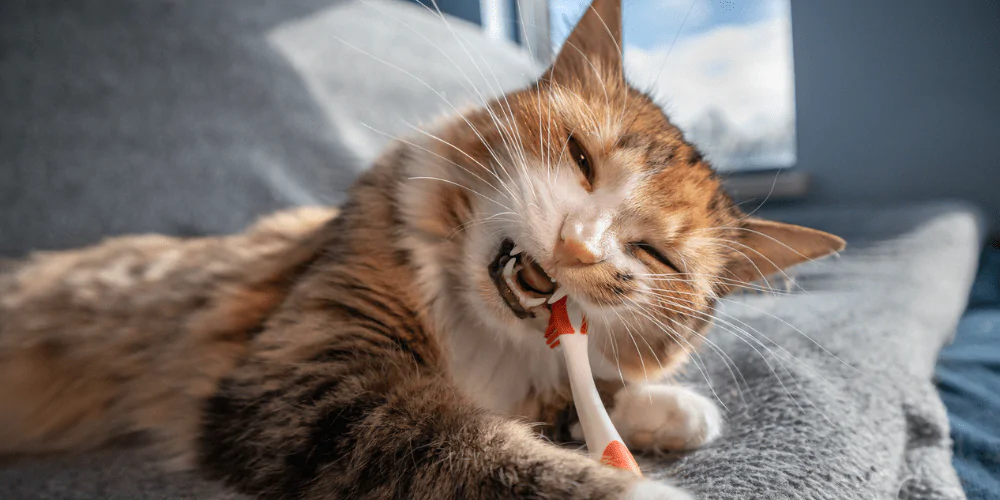
Should I brush my cat’s teeth?
Taking a bit of time each day to do a good dental health routine will help your cat in the long term.
Periodontal disease is the most common dental disease in cats, affecting around 70% of cats over two years of age. Plaque, the film of bacteria that builds up on the teeth after eating, later hardens into tartar if not removed.
This can lead to painful conditions such as:
- Irritated gums
- Tooth loss
- Bacteria spreading to other parts of their body and causing infections
Brushing your cat’s teeth helps:
- Stop plaque and tartar forming
- Keep bad breath at bay
- Prevent conditions like gingivitis and periodontal disease
It takes time and patience, especially if you’re starting when they’re already adults or in their senior years. But most cats will eventually get used to having their teeth brushed.
Remember, it’s never too late to start brushing your feline’s teeth. You’ll just need to get a vet to check for dental disease first.
> When should I start cleaning my cat’s teeth?
Introducing them to teeth brushing at the older kitten stage makes it easier for them to get used to the routine.
So you’re looking to start brushing your cat’s teeth from six months old onwards. Try not to begin any earlier than this – brushing while they’re still teething can be painful. It’s a good idea to get your kitten used to being handled – including around the face and mouth – from an early age.
> What do healthy cat teeth look like?
A cat with a healthy mouth should:
- Have white, clean teeth with no chips
- Have pink gums free of bleeding or swelling
- No lesions, ulcers or unusual bumps
- Not have a foul odour to their breath
Your cat shouldn’t be excessively drooling, pawing at their face, or have problems swallowing. Other symptoms of dental disease in cats include:
- Changes to their appetite (such as favouring soft food only)
- Changes to their eating habits (for example, eating only on one side of the mouth)
- Not grooming themselves
- Altered behaviour (such as hiding away more)
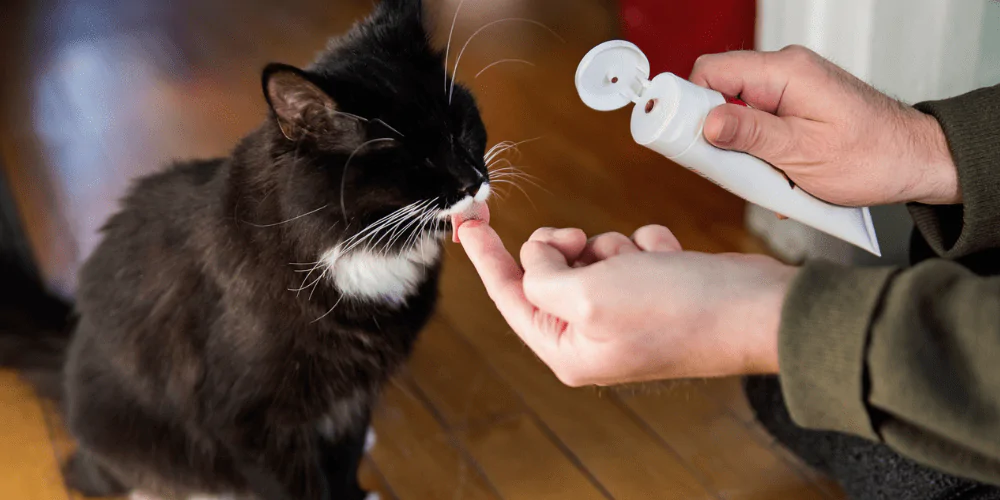
How to clean your cat’s teeth
A gentle pace and lots of praise help to make brushing your cat’s teeth a positive experience. Choose a moment when you’re both calm and relaxed and have some time to dedicate to it.
Ask your vet to recommend a cat-specific toothbrush and toothpaste. Never use human toothpaste as the ingredients could be harmful to your kitty. Leave the toothbrush out for a few days so your cat gets used to it.
- Start by rubbing your finger gently along your cat’s teeth and gums – this helps them get used to their mouth being touched.
- Next, add a little bit of toothpaste to your finger – let your cat become familiar with the taste and texture as you gently rub it around their teeth.
- Put a bit of toothpaste onto the brush and let them lick it – this helps them get used to the texture of the bristles.
- Using a positive tone and lots of praise cues, start brushing in a gentle, circular motion. If your cat becomes stressed or tries to get away, don’t persist. Instead, try again when they’re calm.
- Begin with the easiest teeth to reach, usually the two upper canines – once your cat is comfortable with this, move on to more teeth.
- Don’t forget your cat’s back teeth – you can try gently lifting back their lips or moving the brush inside the cheek to reach them.
> How often should I clean my cat’s teeth?
Brushing your cat’s teeth and gums on a daily basis is the most effective way to keep them healthy. Cats like routine, so try and brush their teeth at a similar time each day.
Starting a new oral routine when your cat is older and a bit reluctant? Try brushing their teeth just a few times a week at first. You’ll then slowly build up the frequency until you’re brushing them once a day.
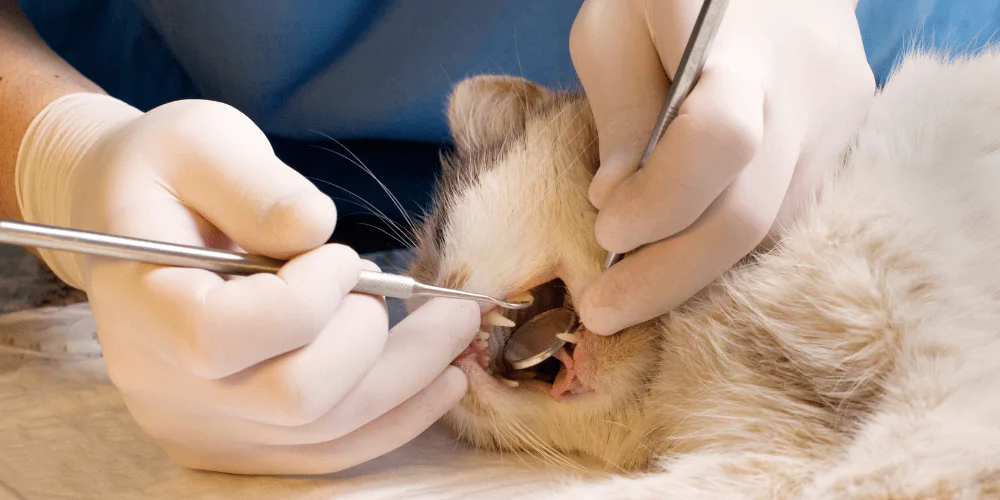
Can a vet clean my cat’s teeth?
Your feline can indeed have their teeth cleaned professionally at the vet. Brushing only removes the soft plaque, so if your cat has a build-up of hard tartar, they’ll need a professional clean. To stop your cat from getting distressed, they’re put under general anaesthesia before work begins.
This allows the vet to do a thorough oral check around the mouth and under the gums, plus any other procedures like x-rays. They’ll check each tooth for lesions or damage, remove plaque and calculus, and polish the teeth.
> What’s the UK vet cost for cat teeth cleaning?
The cost for a professional cat dental cleaning varies depending on where you live in the UK. The price may also go up if your cat needs extra dental work like dental x-rays or a tooth extraction. Take a look at your vet’s website or ask for a price list next time you go in.
Animal Trust, for example, charge a fixed price of £339 for dental work*, which includes:
- A scale and polish
- Anaesthetic
- Pain relief for aftercare (if needed)
- Any extractions found to be needed during the procedure
> What about anaesthetic-free cat dental cleaning?
Anaesthesia-free dental cleaning involves restraining an animal to clean tartar from their teeth. The Royal College of Veterinary Surgeons (RCVS) doesn’t support these procedures and warns that they are not in the best interest of your pet because:
- It doesn’t allow a full exam to be done, meaning problems may be missed or delayed
- Important areas of the tooth, such as by the gumline, can’t be fully and effectively cleaned
- It could cause damage to your pet’s mouth
- It may cause your pet pain, stress or discomfort
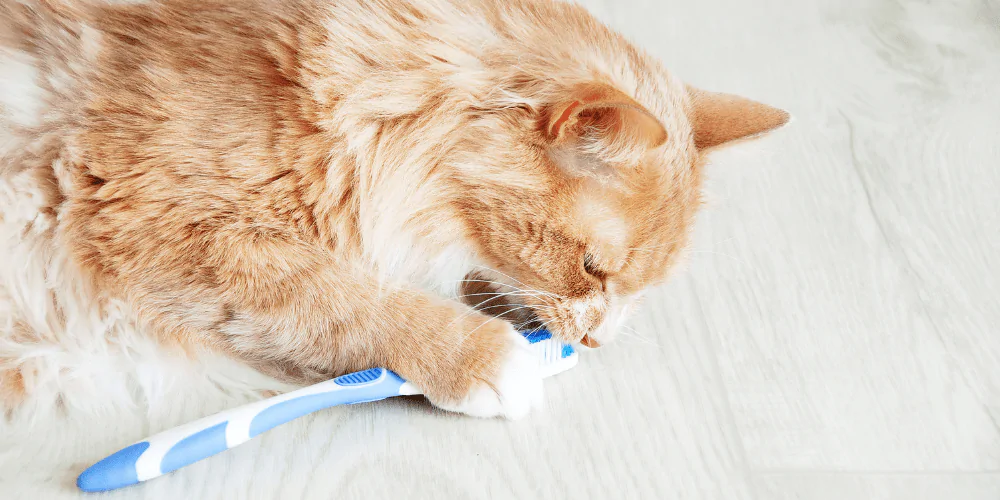
Extra ways to care for your cat’s teeth
There are a few other things you can do to make sure your cat’s teeth stay in tip-top shape:
- Keep up with regular vet check-ups – your vet will examine their teeth and gums to make sure they’re healthy.
- Use Veterinary Oral Health Council (VOHC) recommended products to help manage plaque and tartar build up. This includes topical sprays, gels, and dental sticks.
- Limit the treats – stay away from too many treats, especially ones with high amounts of sugar (this also helps weight management).
- Feed a kibble diet, rather than wet food, or a combination of both.
- Speak to your vet for other recommendations on how to care for your cat’s teeth.
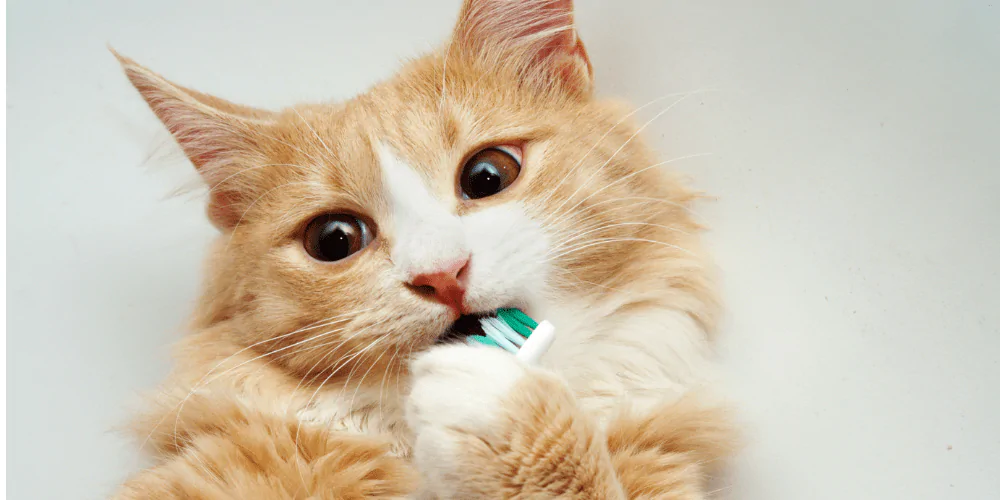
Other cat teeth cleaning questions
> Can you keep a cat’s teeth clean without brushing?
Daily brushing is the most effective way to keep your cat’s teeth clean.
But some cats really struggle with at-home teeth brushing. So in between their annual vet dental cleaning, you can try using:
- Dental cat treats
- Prescription cat dental diet
Dental cat toys - Cat dental gel
> Does kibble clean a cat’s teeth?
As convenient as that would be, kibble isn’t a cleaning tool for your cat’s teeth and can’t remove hard tartar. But some studies have shown that a dry kibble diet may contribute to good oral health.
If needed, your vet can prescribe a dental diet as part of a wider oral hygiene plan.
> Does pet insurance cover dental illness?
Some pet insurance policies offer dental illness cover as standard or as an additional cover option.
Always read your policy wording carefully to see what’s included.
Did you know that you can add on dental illness cover to a Petsure cat insurance policy? The power is in your paws to tailor your cat’s cover to their individual needs.
*Prices correct as of 3 February 2023


